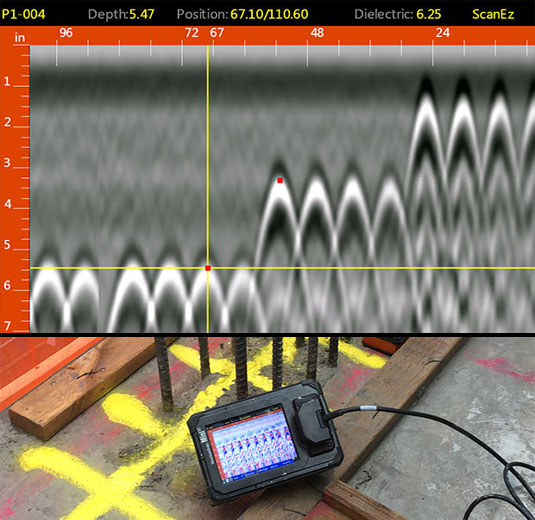RainierGPR Concrete Scanning: Specialist Insights and Ideal Practices
RainierGPR Concrete Scanning: Specialist Insights and Ideal Practices
Blog Article
Exploring the Midst: A Comprehensive Overview to Concrete Scanning and Its Diverse Applications
In the world of building and construction and framework development, the meticulous procedure of concrete scanning holds a crucial role in ensuring the structural stability and security of projects. As modern technology proceeds to develop, the applications of concrete scanning have actually increased far beyond simple surface-level evaluations.
Relevance of Concrete Scanning
Recognizing the importance of concrete scanning is vital in guaranteeing the security and stability of structures throughout construction and restoration tasks. Concrete scanning makes use of innovative technologies such as ground-penetrating radar (GPR) and electromagnetic induction to spot ingrained items, spaces, or other anomalies within concrete frameworks.
Moreover, concrete scanning plays an essential function in guaranteeing compliance with building ordinance and policies that mandate the security of existing architectural components during construction tasks. By accurately mapping out the internal structure of concrete, scanning modern technologies allow building professionals to make educated choices that support the architectural security and sturdiness of structures and facilities jobs. In essence, the significance of concrete scanning lies in its capacity to guard both the architectural honesty and the personnel involved in building and construction ventures.
Technologies Utilized in Concrete Scanning
Concrete scanning counts on innovative technologies such as ground-penetrating radar (GPR) and electro-magnetic induction to accurately identify embedded items and anomalies within concrete frameworks. Ground-penetrating radar operates by sending out high-frequency electro-magnetic waves into the concrete. When these waves run into different materials or spaces within the concrete, they get better to the surface area, allowing the GPR system to produce a thorough subsurface photo. This modern technology is especially efficient in situating rebar, post-tension cables, channels, and various other objects installed in concrete.
Electro-magnetic induction, on the various other hand, functions by creating magnetic fields around a concrete structure through a transmitter coil. When metal things exist within the concrete, they interfere with these electromagnetic areas, triggering eddy currents to flow with the metal. By determining the changes in the magnetic fields with a receiver coil, the system can pinpoint the place of metallic things in the concrete.
These cutting-edge innovations play an essential duty in non-destructive screening, making certain the safety and honesty of concrete structures in numerous industries.
Applications in Building Industry
Within the building sector, concrete scanning modern technology discovers diverse applications that improve job efficiency and security. One crucial application is the detection of rebar, post-tension cables, and other ingrained items prior to boring or reducing right into concrete structures. By properly mapping out these aspects, construction groups can stay clear of costly problems, guarantee structural integrity, and prevent possible safety hazards. Additionally, concrete scanning is used for finding voids, such as air pockets or areas of deterioration within concrete, which can endanger the general stamina of a structure. By recognizing these voids beforehand, building experts can take needed procedures to address them and keep the resilience of the building. Concrete scanning plays a critical role in top quality control by confirming go to these guys the thickness of concrete covers over support, guaranteeing compliance with layout requirements and requirements. In general, the applications of concrete scanning in the construction market add significantly to streamlining job workflows, lowering risks, and supplying top quality results.

Safety Advantages of Concrete Scanning
In the world of building and construction safety, the implementation of concrete scanning innovation presents a vital benefit in preemptively identifying possible threats and fortifying architectural stability. By using sophisticated scanning approaches such as ground-penetrating radar (GPR) and electro-magnetic induction, building teams can accurately situate rebar, post-tension cords, conduits, and various other surprise items within concrete frameworks. This proactive method considerably lowers the threat of accidental strikes during boring, reducing, or coring activities, thereby protecting against expensive problems, injuries, and project hold-ups.
In addition, concrete scanning boosts worker safety and security by giving real-time info regarding the architectural problem of concrete elements. By dealing with prospective safety and security concerns without delay, concrete scanning contributes to producing a safe functioning environment and minimizing the chance of architectural failings or accidents on construction sites.
Future Fads in Concrete Scanning
Arising developments in scanning modern technology are positioned to reinvent the area of concrete evaluation and evaluation. One significant fad that is acquiring traction is the integration of expert system (AI) and maker knowing formulas into concrete scanning gadgets. By harnessing the power of AI, these systems can evaluate huge quantities of data accumulated throughout scanning processes to give more accurate and in-depth understandings into the condition of concrete structures. This can assist in discovering covert problems, predicting potential structural failures, and also suggesting maintenance approaches.
An additional substantial pattern is the development of more mobile and easy to use scanning gadgets. Miniaturization of scanning devices permits for less complicated accessibility to restricted rooms and remote areas, making examinations a lot more efficient and comprehensive. In addition, advancements in Read Full Article cordless communication innovations make it possible for real-time data transfer and evaluation, promoting quicker decision-making processes.
In addition, there is an expanding concentrate on sustainability in concrete scanning modern technologies - RainierGPR Concrete Scanning. Makers are significantly integrating green materials and energy-efficient features right into their devices to lower ecological effect. These future patterns are readied to boost the effectiveness, accuracy, and sustainability of concrete scanning practices, shaping the market's future landscape
Final Thought
In verdict, concrete scanning plays an essential role in the construction sector by making sure the security and effectiveness of different projects. As modern technology advances, the future of concrete scanning holds encouraging growths for enhancing construction processes.

Report this page